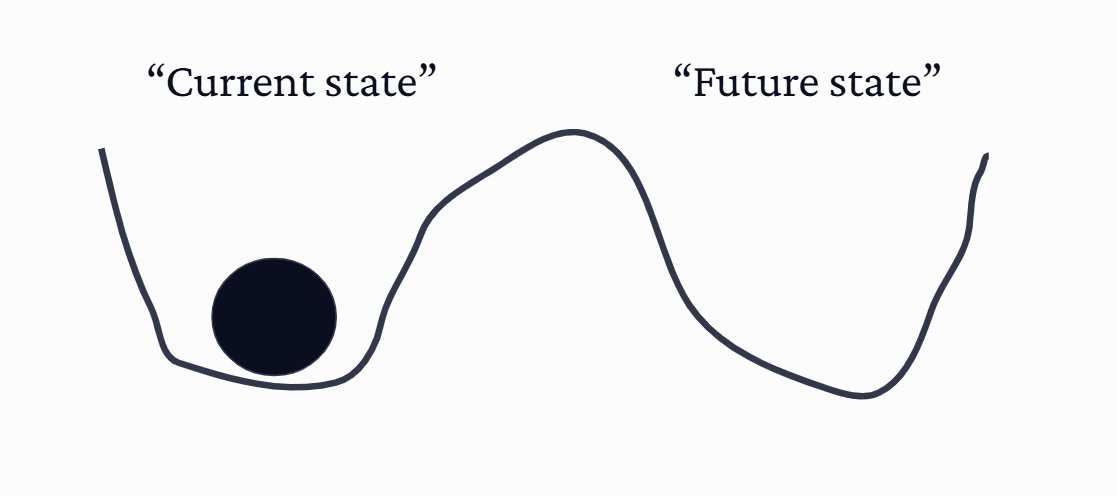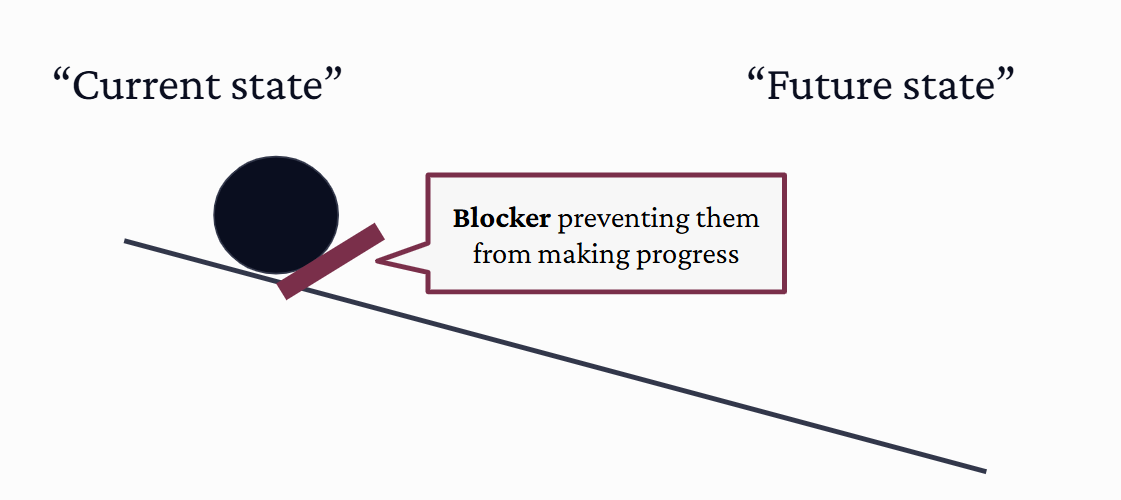0-1 problems are, first, demand problems.
How do we escape the market’s inherent indifference, find traction, break through?
By focusing on one question, two words, eight letters: “Who pulls?”
Now, I’ve dedicated my life to exploring demand. Why do some products fly off the shelves… while others can’t be sold even by very good salespeople?
I think I finally have a good way to visualize what demand *really* looks like. By understanding this, we know what we’re actually looking for, then reverse-engineer how to find it.
Equilibria
Most people are in equilibrium. They have no need to change; it would be weird if they changed. Nobody wakes up in the morning, for example, and says, “Yes! Today’s the day I get to buy new software!”
This is what they look like in equilibrium. (In the graphic below, the ball represents a potential customer who doesn’t have demand.)
In this state, for them to change, they would have to climb a mountain. Or, more likely, you’d have to PUSH them up that mountain.
Importantly, people can be in sh*tty equilibria. They could have plenty of problems and pain points in their equilibrium state, and it doesn’t matter because they are in equilibrium and it would be weird if they changed. There is no demand here.
Instead, we need to look for people who are in disequilibrium - they need to change, are trying to change. That looks like this:
In this situation, the buyer is TRYING to change. But… they are blocked by something. Maybe it’s a technological blocker, maybe it’s a know-how blocker, maybe it’s a cost blocker, maybe it’s something else. The point is, when you put something in front of them that removes this blocker… they would be weird NOT to change and buy. In other words, they PULL. You don’t have to push.
That’s what demand looks like.
We do not control the shape of our buyers’ reality. We don’t decide if there’s a mountain between them and change, or if they are actively trying to change.
We can push buyers up a mountain, but it’s really, really hard. And we have to do it for every single buyer, which is unsustainable, probably not repeatable, and often leads to us having to push them to be successful with our product & renew it.
So. Much. Wasted. Energy.
Instead, the job of the 0-1 founder is best described as “finding people who have demand, and understanding what their demand is.” Doing this, we design around people who are trying to change, and they pull the product out of us… rather than us carrying people up mountains.
Look at these two graphics again:
The crazy thing? These two graphics can represent the same person, at two different points in time. Or the same person at the same time, with two different priorities.
So the questions that really matter:
What causes someone to go from “equilibrium” to “disequilibrium”? When does this happen?
What is the progress they’re trying to make, and why are they blocked from making progress by their current set of options?
Every startup I’ve seen grow super fast has designed around people who were trying to change but were blocked.
Lovable and Bolt, for example, found that people like me are trying to design websites and apps but are blocked by our technical and design incompetence, and even the “easy to use” visual editors are just too much work & come out with bad results.
Jump, as another example, found that financial advisors were trying to cut admin time using AI notetakers, but had specific (product + legal) requirements that blocked them from getting value out of the generic ones.
It doesn’t have to be a huge market up front - it can be a tiny, tiny niche. But they MUST have demand, otherwise the slog never ends.
So, what are you looking for? Someone trying to accomplish something, but blocked. NOT someone in equilibrium.
—
PS:
Funny thing about Waffle - startups are using it as “1-click AWS setup”, not even for SOC 2 compliance. If you need to set up AWS with all bells & whistles (monitoring, CICD, alerts, autoscaling, load balancing, etc) - give Waffle a try or schedule a session with us to set it up!





Nice visuals.
An important point – people in equilibrium will absolutely complain about their current state and tell you they'd love the new state, and then do exactly nothing about it.
You can spot the people in disequilibrium because they're already putting in effort to try to get over the blockage.